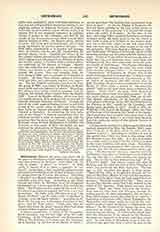

Gethsemani, Abbey of OUR LADY OF, of the Order of Reformed Cistercians, commonly called Trappists, established in 1848 in Nelson Co., Kentucky, in the Diocese of Louisville, being the first abbey on American soil. On October 26, 1848, a colony of forty Trappists left the Abbey of Melleray, in the Diocese of Nantes, France, under the leadership of Dom Eutrope Proust, and arrived at New Orleans early in December. They traveled by river to Louisville, Ky., where Bishop Flaget, who had greatly desired their coming, received them. On December 21 they took possession of the lands destined for their establishment, and shortly afterwards their number was increased by a second colony of twenty religious from the motherhouse. The monks undertook the work of clearing their lands with indomitable energy, and little by little arose the imposing structures which form the present abbey. This is an immense quadrilateral, one side of which is formed by the church, whilst the other three sides contain the monastic quarters, with a commodious guest-house for those who desire to spend a few days in solitude.
In 1850 a pontifical Brief (July 21) erected the new monastery into an abbey. By a unanimous vote Dom Eutrope was elected abbot, and on May 1, 1851, received the abbatial blessing from Bishop M. J. Spalding of Louisville, in the old cathedral of Bards-Spalding of Louisville, in the old cathedral of Bardstown. It was the first ceremony of the kind performed in North America. In 1859 Dom Eutrope resigned and returned to France. He left Dom Benedict Bergerin charge, who was soon after elected abbot, and received the abbatial blessing in St. Catherine’s Church, New Haven, Ky., May 9, 1861. Dom Benedict insisted with true religious zeal on the observance of the rule, and under his administration the abbey buildings were finished. The church was solemnly consecrated by Archbishop Purcell of Cincinnati, November 15, 1866. Stricken with paralysis in 1887, Dom Benedict resigned his charge in 1889. The administration then passed to Dom M. Edward Chaix-Bourbon, who was elected abbot May 9, 1890, and received the abbatial blessing in the church of the monastery, September 29 following. Dom Edward applied himself especially to improve the school attached to the abbey since its foundation. He erected new buildings, and transformed it into a college. During a visit to France, upon the advice of physicians, he had to renounce his hopes of seeing Gethsemani again, and on January 24, 1898, he was succeeded by Dom M. Edmond M. Obrecht, first appointed superior and shortly afterwards elected abbot by unanimous vote; he received the abbatial blessing at Gethsemani, October 28, 1898. Through the generosity of Msgr. Batz of Milwaukee, Dom Edmund was able to create the splendid library which contains more than thirty thousand volumes of the principal authors on ecclesiastical sciences.
That the regime of La Trappe is entirely incompatible with the American temperament is a prejudice without foundation. The community has always numbered some, and now numbers over one-third, Americans amongst its religious, some of whom were raised in luxury, and all have found health and happiness at Gethsemani. Another prejudice is the belief that the Trappist life, being a penitent life, is only intended for criminals. Life at Gethsemani is the same as Cistercian life at Clairvaux, a life of contemplation and penance. Moreover, recent decrees of sovereign pontiffs and the constitutions of the order forbid the reception of men who have given public scandal. The community of Gethsemani is at present (1908) composed of 80 religious: 34 members of the choir, 22 of whom are priests, whilst the others are preparing themselves, by the regular studies, for the priesthood; 46 are lay brothers who are more especially engaged in the work of the farm.
EDMOND M. OBRECHT

